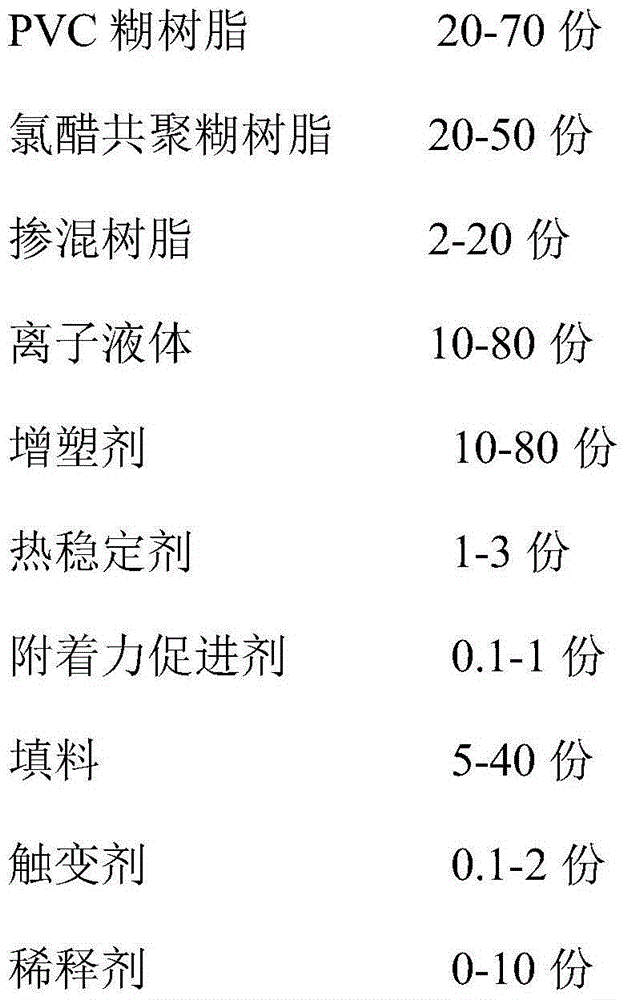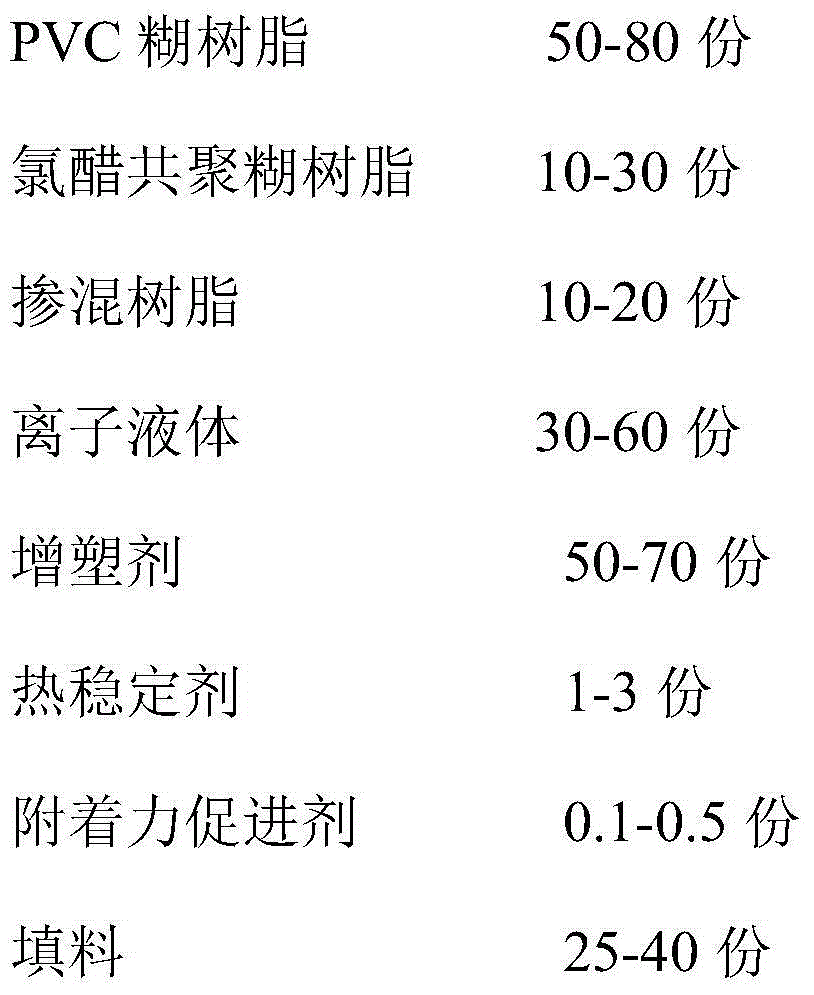Low temperature plasticized polyvinyl chloride plastisol and preparation method thereof
A technology for polyvinyl chloride and plastisol is applied in the field of polyvinyl chloride plastisol and its preparation, which can solve the problems of increasing exhaust gas emission, complicated process, increasing environmental protection pressure, etc., and achieves the effects of lowering plasticizing temperature and simple preparation process.
- Summary
- Abstract
- Description
- Claims
- Application Information
AI Technical Summary
Problems solved by technology
Method used
Image
Examples
Embodiment 1
[0041] Add PVC paste resin, vinyl chloride-vinyl chloride paste resin, blending resin, ionic liquid, plasticizer, heat stabilizer, adhesion promoter, filler, thixotropic agent and diluent according to the parts in the table.
[0042] in:
[0043] The PVC paste resin is an emulsion polymer resin with a polymerization degree of 1000, the vinyl chloride resin is an emulsion polymer resin with a polymer 800, the blended resin is SB100, and the ionic liquid is 1-allyl-3-methylimidazolium chloride, plasticized The agent is dioctyl phthalate, the heat stabilizer is organotin, the adhesion promoter is closed-end polyurethane, the filler is light calcium carbonate, the thixotropic agent is nano-silica, and the diluent is C 12 isoparaffins. The preparation method is as follows: at room temperature, after mixing the components, fully dispersing and evenly, vacuum defoaming for 3 hours, and then aging for 24 hours, the product is prepared, and the plasticizing temperature of the product ...
Embodiment 2
[0045] Add PVC paste resin, vinyl chloride-vinyl chloride paste resin, blending resin, ionic liquid, plasticizer, heat stabilizer, adhesion promoter, filler, thixotropic agent and diluent according to the parts in the table.
[0046] in:
[0047] The PVC paste resin is an emulsion polymer resin with a polymerization degree of 1200, the vinyl chloride resin is an emulsion polymer resin with a polymer 900, the blended resin is SB100, the ionic liquid is 1-butyl-2-methylpyrazole bromide, plasticized The agent is diisodecyl phthalate, the heat stabilizer is organotin, the adhesion promoter is polyamide, the filler is light calcium carbonate, the thixotropic agent is nano-silica, and the diluent is C 18 isoparaffins. The preparation method is as follows: at room temperature, after mixing the components, fully disperse and evenly, vacuum defoaming for 5 hours, and then aging for 24 hours, the product is prepared, and the plasticizing temperature of the product is 127°C.
Embodiment 3
[0049] Add PVC paste resin, vinyl chloride-vinyl chloride paste resin, blending resin, ionic liquid, plasticizer, heat stabilizer, adhesion promoter, filler, thixotropic agent and diluent according to the parts in the table.
[0050] Among them, the PVC paste resin is an emulsion polymer resin with a polymerization degree of 800, the vinyl chloride resin is an emulsion polymer resin with a polymer 1200, the blended resin is SB100, and the ionic liquid is 1-butyl-3-methylimidazolium chloride, plasticized The agent is diisobutyl phthalate, the heat stabilizer is organotin, the adhesion promoter is polyamide, the filler is light calcium carbonate, the thixotropic agent is nano-silica, and the diluent is C 16 isoparaffins. The preparation method is as follows: at room temperature, the components are mixed fully and evenly dispersed, vacuum degassed for 6 hours and then matured for 48 hours to prepare the product. The plasticizing temperature of the product is 121°C.
PUM
| Property | Measurement | Unit |
|---|---|---|
| particle size | aaaaa | aaaaa |
| degree of polymerization | aaaaa | aaaaa |
Abstract
Description
Claims
Application Information
 Login to View More
Login to View More - R&D
- Intellectual Property
- Life Sciences
- Materials
- Tech Scout
- Unparalleled Data Quality
- Higher Quality Content
- 60% Fewer Hallucinations
Browse by: Latest US Patents, China's latest patents, Technical Efficacy Thesaurus, Application Domain, Technology Topic, Popular Technical Reports.
© 2025 PatSnap. All rights reserved.Legal|Privacy policy|Modern Slavery Act Transparency Statement|Sitemap|About US| Contact US: help@patsnap.com



